How To Detect Fake Gold Bars
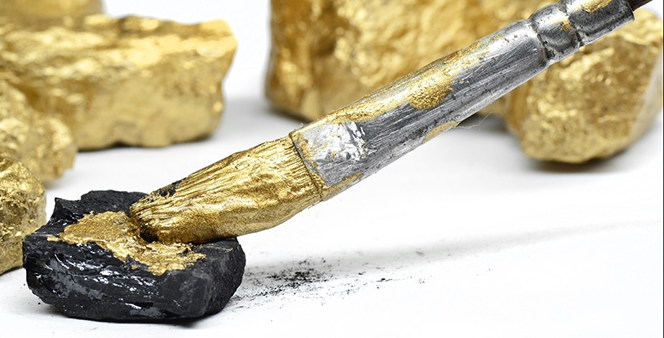
What is Fake Gold?
Gold has been a symbol of wealth and power for centuries and is a popular investment choice for many people. However, counterfeiting fake gold jewelry is a growing problem in the precious metals industry, and fake gold bars are one of the most common counterfeit precious metals products. Fake gold bars can be made of cheaper metals or alloys and are often gold plated with a layer of gold to give them the appearance of real gold. In this article, we will discuss how to detect fake gold bars and ensure the authenticity of your investment.
Why It's Important To Detect Fake Gold Bars
Detecting fake gold bars has become increasingly crucial in recent years due to the rise of counterfeit gold products in the market. Counterfeiters have become more sophisticated in their methods of using heavy gold-plated items, making it difficult to differentiate between genuine and fake gold bars. Therefore, it is essential to understand the significance of detecting fake gold bars to avoid any potential loss.
Investing in fake gold bars can result in significant financial loss for investors. These counterfeit goods are often sold at lower prices compared to genuine gold bars, making them attractive to unsuspecting buyers. Unfortunately, once the purchase has been made, the fake gold cannot be sold for its actual value, leaving the investor with substantial monetary losses.
Additionally, investing in fake gold bars may lead to legal implications. The use of counterfeit gold products is considered fraud and is punishable by law. This can result in hefty fines and even jail time for those involved. Furthermore, buying fake gold bars can damage one's reputation in the industry, leading to significant reputational loss.
Visual Testing
Visual tests rely on the appearance and visual characteristics of the metal to determine whether it is genuine or counterfeit. Visual tests are convenient, quick, and inexpensive, making them an ideal first step in detecting potential fraud in precious metals.
Markings On The Bar
When it comes to detecting a fake gold bar, the markings on the bar are crucial features to take note of. Although markings are not on every bar, most mint and gold bars do have certain characteristics that can help identify the authenticity of the gold bar. Genuine gold bars have unique markings that set them apart from counterfeit ones.
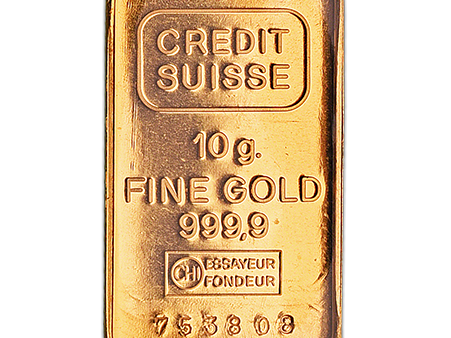
There are multiple different types of gold bars. However, in order to examine the markings of a gold bar, we are going to take a deeper look at the Credit Suisse gold bar.
The first marking on the Bar is the manufacturer logo, which in this case is the Credit Suisse logo stamped above the other information on the bar. The logo consists of the words CREDIT SUISSE in a rectangular box. These logos can vary depending on the type of gold bar; for example, there are also PAMP Suisse, Valcambi, Perth Mint, Johnson Matthey, and many more.
Genuine gold bars also typically include the weight of the bar, usually measured in troy ounces, grams, or kilograms. Under the weight marking, the gold bars typically also include purity. This means that the gold bar contains 99.99% pure gold. The fineness is usually indicated on the bar itself, often near the manufacturer logo or elsewhere on the bar's surface.
Below the purity of the gold bar, we typically have the assayer's mark of the bar. An assayer's mark is a stamp or logo that represents the organization responsible for testing and certifying the bar's purity and weight. Credit Suisse gold bars often feature the assayer's mark of Essayeur Fondeur, which is a common assayer's mark used by several Swiss precious metals refiners, including PAMP Suisse and Valcambi. Other assayer's marks include Assay Office of United Kingdom, Argor-Heraeus, Peth Mint, Johnson Matthey, and many more. When you see "CHI" as part of an assayer's mark on a gold bar, it signifies that the gold bar was produced or assayed in Switzerland. This letter will carry depending on where the bar was produced.
Some gold bars may also include the logo or emblem of the refinery responsible for producing the bar. In the case of Credit Suisse, their gold bars often display the Valcambi refinery logo, signifying that the bar was refined by Valcambi.
To ensure authenticity and traceability, gold bars often have a unique serial number engraved on them. This number helps track the bar's origin and authenticity. It is usually located on the front or back of the bar and is typically a combination of letters and numbers.
Color Differences
Checking for color variations can be a quick and easy method to determine if a gold bar is genuine or fake.
Real gold has a consistent color throughout the entire piece, while fake gold may have different shades of yellow, red, or even green. To identify any color differences, you can compare the gold bar's color to known genuine gold items such as coins or jewelry.
Another option is to hold the gold bar up to a light source and look for any variations in color or tint. This can help to highlight any inconsistencies in the gold's color, indicating that it may not be genuine.
It's important to note that some fake gold bars may have a layer of gold plating, which can make them look more like genuine gold. However, the plating can wear off over time, so it's still important to check for any color differences.
Testing Gold - Physical Tests
Before investing in gold bars, it's crucial to ensure their authenticity to avoid hefty financial losses and potential legal implications. Physical tests are some of the commonly used methods to detect if gold is real. These tests involve verifying the physical attributes of the gold bar, such as its weight, density, magnetism, and reaction to various acids.
Weight And Size Comparison
One of the easiest tests is to check the weight and dimensions of the gold bar to make sure they match the expected values. For example, a fake Credit Suisse gold bar may be lighter or heavier than it should be or have different measurements than expected. Therefore, it is important to have an idea of what the expected weight and dimensions are for the specific type of gold bar you are examining.
Using a scale and a measuring tape, you can obtain accurate readings of the weight and dimensions of the gold bar. Compare these measurements to the refiner's expected values and take note of any discrepancies. It is essential to remember that gold is a dense metal. Hence, a fake bar made of cheaper metals will have larger dimensions than a real gold bar with the same weight. Therefore, if you suspect that a gold bar is fake, you can use this knowledge to your advantage by checking its dimensions. If it is larger than it should be, it may not be made of genuine gold.
Magnet Test
A magnetic test is a simple and commonly used method to identify the authenticity of gold bars. Pure gold is not magnetic, so if a gold bar exhibits magnetic properties, it may indicate that it is not made of pure gold or contains magnetic impurities. Here's what you would need and the process for conducting a magnetic test on gold bars:
Materials Needed:
- Gold bars
- Strong neodymium magnet: Neodymium magnets are the strongest commercially available magnets and exhibit extremely high magnetic properties
- Clean, non-magnetic surface
Procedure:
- Ensure that the neodymium magnet is clean and free from any magnetic particles or debris.
- Place the gold bar on a clean, non-magnetic surface, such as a wooden table or a piece of glass.
- Bring the neodymium magnet close to the gold bar without touching it.
- Observe the interaction between the magnet and the gold bar: a. If the gold bar is not attracted to the magnet or shows no signs of magnetic response, it is likely made of pure gold. Pure gold is not magnetic. b. If the gold bar is attracted to the magnet or exhibits signs of magnetic response, it suggests the presence of magnetic impurities or that the gold bar is not made of pure gold.
It is essential to note that the magnetic test should not be relied on as the sole indicator of authenticity since counterfeiters can use non-magnetic metals to imitate gold bars. Additionally, this test is not suitable for detecting gold alloys, which are commonly used in jewelry.
Density Test
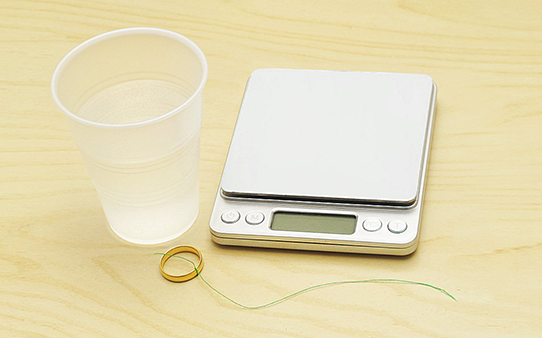
The density test checks the high density of gold against that of other metals commonly used in fake gold bars. Gold has a density of 19.3 grams per cubic centimeter (g/cc), which means a fake gold bar with a different density will be easily identified. The density test can be performed either with a gold density tester. However, due to the high cost, it can also be done with a traditional water scale.
To conduct the Density Test, you will need a few tools and equipment:
- Genuine gold bar
- Cylinder or vial with milliliter markings.
- Water
- Scale to weigh the gold piece.
- Calliper to measure the dimensions of the gold piece.
Steps to test the density of a gold piece:
1. The first step is to weigh the gold bar accurately using a precise scale. The weight is typically recorded in grams or ounces.
2. A container of water is placed on a stable surface. The water level is marked or recorded, ensuring it remains consistent throughout the test. Then, the gold bar is gently submerged in the water, and the increase in water level due to the gold bar is noted.
3. The increase in water level corresponds to the volume of water displaced by the gold bar. This volume is a measure of the volume of the gold bar itself.
4. The density of the gold bar is determined by dividing its weight by its volume. The formula for density is density = mass/volume. The mass of the gold bar is obtained from its weight measurement, and the volume is calculated based on the water displacement.
5. The calculated density of the gold bar is then compared to the expected density of pure gold. Pure gold has a known density of approximately 19.3 grams per cubic centimeter (g/cm³). If the measured density closely matches the expected density, it suggests that the gold bar is likely authentic and of high purity. Significant deviations in density could indicate the presence of impurities or non-gold metals.
Example Calculation:
A Credit Suisse gold bar weighs 31.1 grams, measures 40mm x 24mm x 2.2mm, and displaces 0.8 ml of water when dropped in. What is its density?
- Volume of the gold piece = 0.8 ml
- Weight of the gold piece = 31.1 g
- Density of the gold piece = Weight / Volume = 31.1 g/0.8 ml = 38.9 g/cc
A genuine Credit Suisse gold bar has a density of 19.3 g/cc, so a reading higher than this indicates that the gold piece may be fake. This test is useful in identifying fake manufacturers who mix cheaper metals to mimic the weight of real gold.
Destructive Testing
Nitric Acid Test
The acid test involves applying nitric acid to a small area of the gold bar and observing the reaction. The process requires 10-14% concentrated nitric acid and the gold bar that is to be tested.
Steps to perform an acid test:
1. Choose a small, inconspicuous area on the gold bar where the test can be performed. It's best to choose an edge or an area that won't significantly affect the appearance or value of the bar.
2. Use a file or a sharp tool to create a small scratch or groove on the selected area of the gold bar. The scratch should be deep enough to expose the metal underneath the surface layer.
3. Apply nitric acid: Place a drop of nitric acid onto the scratched area of the gold bar. Observe the reaction that occurs.
Genuine gold is highly resistant to nitric acid, so if the gold bar is pure, it should not exhibit any significant reaction. The acid should not cause any visible changes, such as color alteration or dissolution of the metal.
Depending on the observed reaction, the results can be interpreted as follows:
- No reaction or minimal reaction: This indicates that the gold bar is likely genuine and of high purity.
- Color change or dissolving: If the gold bar shows a green or milky appearance, bubbling, or dissolves partially or completely, it suggests the presence of non-gold metals or impurities, indicating that the gold bar may not be genuine or of lower purity.
It is important to note that the acid test only tests the surface of the gold bar and does not detect whether an item is merely gold-plated. If you suspect that the gold bar might be gold-plated, you should use a different method to verify its authenticity.
Fire Assay

Assay testing is a reliable method for verifying the authenticity and purity of gold bars. This process involves melting down a small piece of the gold bar and analyzing its chemical composition to determine the percentage of gold content.
Professional assayers or laboratories typically perform this test since it requires specialized equipment and expertise. During the assay testing procedure, a small sample of the gold bar is melted in a crucible. The melted gold is then mixed with a special flux material that helps remove any impurities present in the sample.
After the flux has been added, the mixture is poured into a mold and allowed to cool and solidify. Once the sample has solidified, it is ready for testing. The assayer will then use various methods to analyze the sample, including spectroscopy, gravimetry, and fire assay.
These methods help determine the percentage of gold content in the sample. The assayer will then compare the gold content in the sample to the expected purity of the gold bar. If the percentage of gold in the sample is within an acceptable range, the gold bar is determined to be authentic and pure.
Non-destructive Testing
When it comes to detecting fake gold bars, several tests can be conducted to determine their authenticity that do not damage the condition of the precious metal. Reputable dealers and precious metal experts often rely on these tests to evaluate the gold content and fineness of gold bars to ensure they are genuine.
X-Ray Fluorescence Testing (XRF)
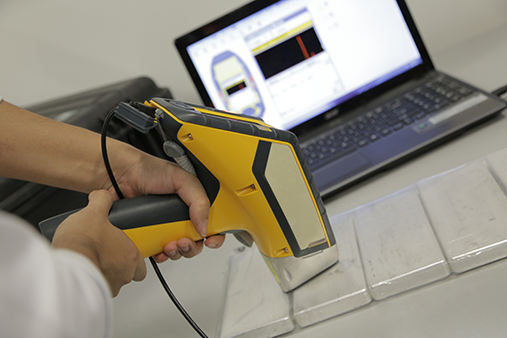
When it comes to detecting how much gold is in bars and coins, one of the most reliable methods is X-ray fluorescence analysis or XRF. This non-destructive testing method measures the gold purity of an object using X-ray technology. Here's how it works:
An XRF analyzer bombards the gold object with high-energy X-rays, causing the atoms in the gold to emit fluorescent X-rays of their own. The XRF analyzer then measures the intensity and energy of these fluorescent X-rays and uses that data to determine the karat weight or gold purity of the object.
One of the benefits of XRF is that it is a fast and accurate method for determining the authenticity of gold bars and coins. It can provide results almost instantly, and its accuracy rate is typically around 99.7%, making it a highly reliable method.
However, XRF has its limitations. It can only detect the gold purity of an object's surface and may not be able to detect heavily gold-plated fake bars, which have a thin layer of gold over a cheaper metal.
It's also crucial to understand how to interpret XRF results properly. While XRF analysis can accurately determine the karat weight of gold in an object, it does not provide information about the object's overall authenticity or origin. It's essential to work with reputable and knowledgeable precious metal experts or dealers to obtain a comprehensive assessment.
Ultrasound Testing

Ultrasound testing for gold, also known as ultrasonic testing (UT), utilizes high-frequency sound waves to examine the internal structure and integrity of a gold bar. The basic principle behind ultrasound testing is the transmission of sound waves through a material and analyzing the reflected waves to detect any irregularities or defects.
Ultrasound testing equipment consists of a transducer, which generates the sound waves, and a receiver that detects the reflected waves. This handheld device has a probe that is placed in contact with the surface of the gold bar.
The transducer emits high-frequency sound waves (ultrasound) into the gold bar. These sound waves travel through the material at a constant speed. When the sound waves encounter an interface or a defect within the gold bar, they are partially reflected back to the device. The timing and intensity of the reflected waves provide information about the internal structure of the gold.
The receiver picks up the reflected waves and sends the data to a computer or display unit. The system analyzes the received waves and generates a visual representation of the internal structure of the gold bar, often in the form of a real-time image or a cross-sectional view. By analyzing the ultrasound image, technicians can identify any inconsistencies, voids, or defects within the gold bar. These could include impurities, air pockets, cracks, or inclusions that may affect the integrity or purity of the gold.
Electrical Conductivity Testing
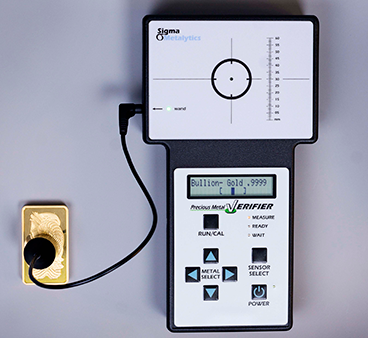
Precious metals have distinct electrical conductivity properties. Electrical conductivity testing measures how well a metal conducts electricity. By comparing the electrical conductivity of a metal with established standards, it is possible to determine its authenticity even through the thin plastic packaging of gold bars.
Electrical conductivity testing for gold bars involves measuring the electrical conductivity of the gold to assess its purity and authenticity. This testing method provides an indication of the gold's conductive properties and can help identify the presence of impurities or other metals. A precious metals verifier, which is a specialized device designed for assessing precious metals, can be used in conjunction with electrical conductivity testing. A precious metals verifier can be used as a tool in the electrical conductivity testing process to enhance accuracy and reliability by assessment of the gold bar's authenticity and purity
The instrument typically consists of two electrodes and a display unit. The electrodes of the conductivity meter are placed in direct contact with the gold sample. It is important to ensure proper alignment and firm contact between the electrodes and the gold surface.
Once the electrodes are positioned correctly, a small electrical current is passed through the gold sample using the conductivity meter. The instrument measures the resistance encountered by the current as it flows through the gold. The conductivity meter measures the resistance and converts it into an electrical conductivity value. This value represents how easily the electrical current passes through the gold sample.
Higher-purity gold, with fewer impurities, will exhibit higher electrical conductivity. The measured electrical conductivity value is compared to known conductivity values for pure gold or standard references. Significant deviations from the expected conductivity range may indicate the presence of impurities or other metals in the gold sample.
The More, The Better
After having looked at a multitude of different gold testing methods, it is important to note that each method has its advantages and disadvantages. Some testing methods work despite gold being wrapped in plastic, whereas others don't. Some methods are easier to manipulate with other metals, whereas others are very difficult. It is, therefore, very important to use multiple testing methods to minimize the probability of purchasing counterfeit gold bars. There are certain methods that correlate well together because they eliminate each other's weaknesses; here is more information on testing methods that have proven to be especially effective when used together.
Other Ways to Avoid Buying Fake Gold Bars
When it comes to investing in precious metals, gold has remained a popular option for many years. Unfortunately, with the rise in counterfeit gold products on the market, it has become increasingly important to take measures to ensure that you are getting genuine gold. Here are some other ways to avoid buying fake gold bars:
1. Purchase from Reputable Bullion Dealers and LBMA Accredited Refiners
One way to ensure that you are getting authentic gold bars is to only buy from reputable bullion dealers and LBMA (London Bullion Market Association) accredited refiners. These dealers and refiners have established a reputation for selling high-quality gold products. Buying from unknown or unaccredited sellers can increase the likelihood of purchasing fake gold bars.
2. Only Buy From Trusted Facilities
Another option is to only buy gold bars that have been minted at trusted facilities such as the U.S. Mint, the Perth Mint of Australia, the Austrian Mint, the Royal Canadian Mint, and the Shenyang Mint. These mints have strict quality control procedures in place, making it difficult for counterfeiters to replicate their products accurately.
3. Consider Using Professional Tests
Professional tests like X-Ray Fluorescence Testing (XRF) or Assay Testing can also help you determine if a gold bar is authentic. XRF testing uses X-rays to determine the composition of gold, while Assay testing involves melting a small sample of the gold bar and analyzing it for purity. These tests are more expensive than physical tests but provide the most reliable results.
4. Perform Physical Tests
Physical tests can also help you detect fake gold bars. These tests include weight and size comparison, magnetic test, density test, acids test, and scratch test. It is important to note, however, that some fake gold bars can pass these tests, making them less reliable than professional tests or purchasing from reputable dealers.
In conclusion, when purchasing gold bars, it is crucial to take measures to ensure that you are getting authentic gold. Researching reputable dealers and refiners, purchasing from trusted facilities, and using professional or physical tests can all help detect fake gold bars.
